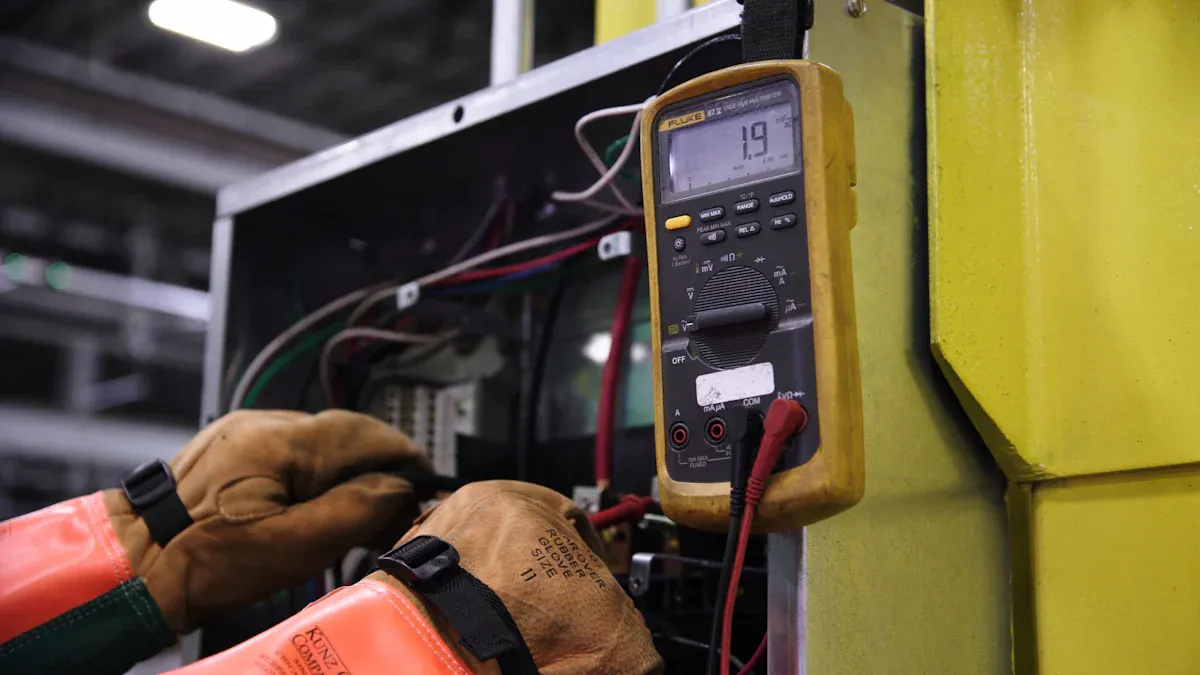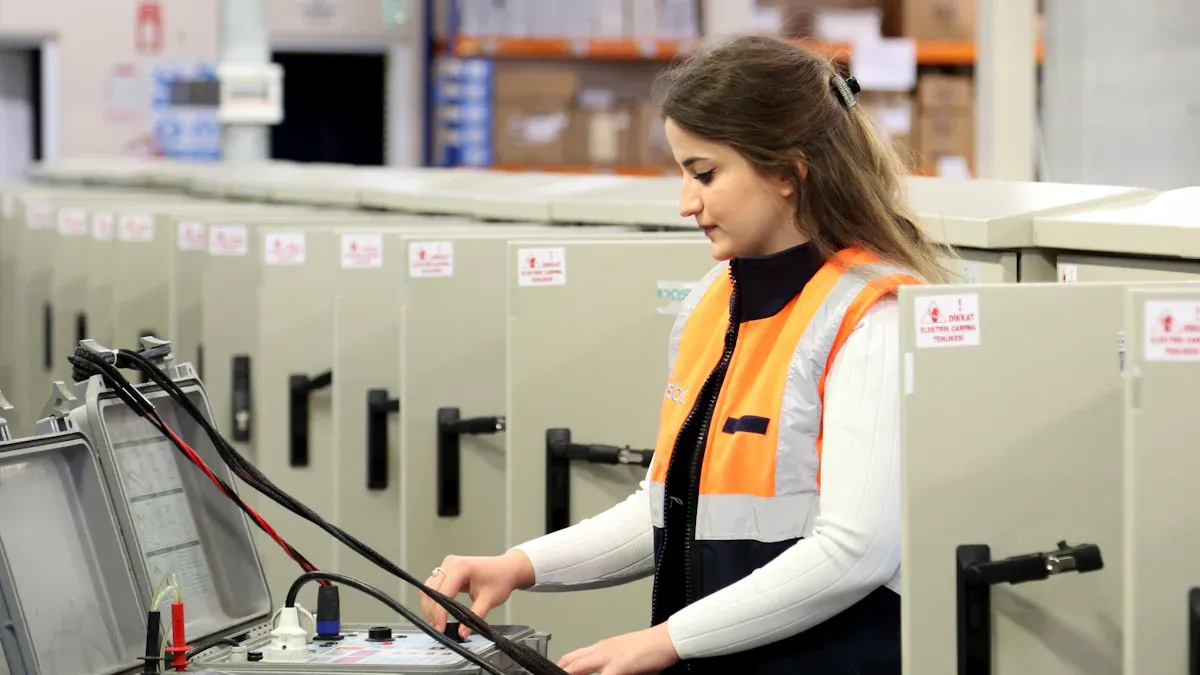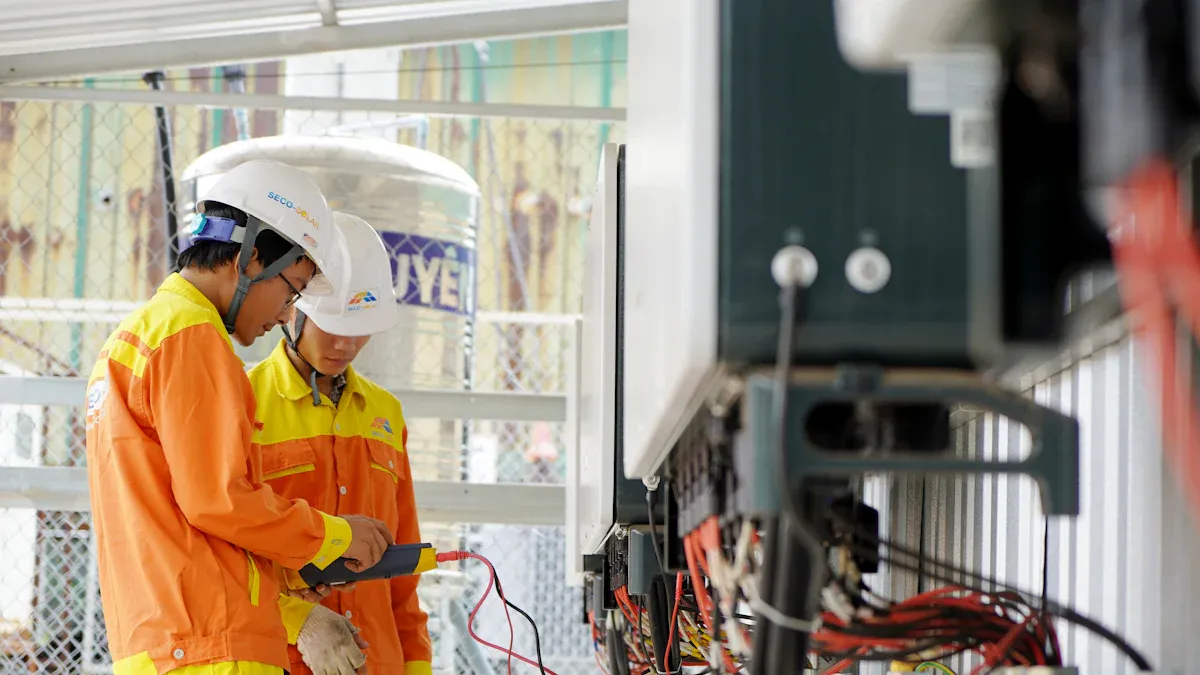Rack Mount Rectifier Solutions for Safer Factories

Factories often rely on robust power solutions such as the TDK-Lambda HFE1600, Delta Electronics DPR 3000B, and Mean Well RCP-1600 Series. Each rack mount rectifier delivers stable DC power while supporting critical industrial equipment. Advanced safety features like current limiting and thermal protection help prevent electrical hazards. Compliance with international standards ensures that every rectifier meets strict safety requirements. Efficient power conversion from these rack mount rectifier units reduces operational risks and supports reliable production environments.
Key Takeaways
Rack mount rectifiers provide stable and safe DC power to protect critical factory equipment and reduce electrical risks.
Advanced safety features like current limiting, thermal protection, and alarms help prevent equipment damage and fires.
Reliable rectifiers support redundancy and parallel operation to keep power steady even if one unit fails.
Energy-efficient designs lower operating costs and heat output, extending equipment life and supporting sustainability.
Choosing the right rectifier means matching power needs, safety standards, and budget while consulting technical datasheets and trusted suppliers.
Rack Mount Rectifier Safety Criteria

Safety Features
Rack mount rectifier systems protect industrial environments by integrating advanced safety features. Current limiting prevents excessive current from damaging sensitive equipment. Thermal management systems, such as intelligent fans and temperature sensors, help maintain safe operating conditions. Many rectifier systems include built-in alarms that alert operators to abnormal conditions. These features reduce the risk of electrical fires and equipment failure. Compact design allows for easy installation in crowded control panels, supporting industrial power management strategies. Certifications from organizations like UL and IEC confirm that each rectifier meets strict safety standards. Modular options, including DIN rail mounting, offer flexibility for expanding or upgrading rectifier systems as factory needs change.
Reliability Standards
Manufacturers design rack mount rectifier systems to deliver consistent performance and operational reliability. Redundancy plays a key role in maintaining equipment uptime. Many rectifier systems support parallel operation, so if one unit fails, others continue to supply stable DC output. This approach ensures uninterrupted output and protects critical processes. High-quality components and rigorous testing contribute to long-term reliability. Compliance with international standards, such as IEC 62368-1, demonstrates a commitment to safety and reliability in industrial power management.
Efficiency and Compliance
Energy efficiency remains a top priority for modern rectifier systems. High conversion efficiency reduces energy loss and lowers operating costs. Efficient rack mount rectifier designs also minimize heat generation, which supports longer component life and reduces cooling requirements. Compliance with global standards, including RoHS and CE, ensures that each rectifier system meets environmental and safety regulations. These factors help factories achieve both safety and sustainability goals while maintaining stable DC output and redundancy across all critical systems.
Best Rack Mount Rectifier Models
TDK-Lambda HFE1600 Series
The TDK-Lambda HFE1600 Series stands out as a high-performance solution for industrial power needs. This rack mount rectifier delivers up to 1600W per unit and supports parallel operation for higher capacity. Engineers designed the HFE1600 Series with advanced safety features, including current limiting and over-temperature protection. The system includes built-in alarms for fault conditions, which helps operators respond quickly to issues.
Key Safety and Reliability Features:
Current limiting and short-circuit protection
Over-voltage and over-temperature safeguards
Hot-swappable modules for minimal downtime
IEC and UL certifications
Pros:
High efficiency (up to 92%)
Modular design for easy expansion
Wide input voltage range
Cons:
Higher initial cost compared to basic models
Requires careful airflow management in dense racks
Ideal Applications:
Factories with critical automation, process control, or data acquisition systems benefit from the HFE1600 Series. The model suits environments that demand high reliability and flexible rectifier systems.
Note: TDK-Lambda HFE1600 units are widely available through authorized distributors. Lead times may vary based on configuration. Always consult the latest technical datasheets for precise specifications.
Delta Electronics DPR 3000B
Delta Electronics offers the DPR 3000B as a robust rack mount rectifier for demanding industrial settings. This model provides up to 3000W output and supports N+1 redundancy, which ensures continuous operation even if one module fails. The DPR 3000B features intelligent fan control and comprehensive monitoring through digital interfaces.
Key Safety and Reliability Features:
Advanced thermal management
Digital monitoring and remote control
Redundant operation for maximum uptime
Compliance with IEC and CE standards
Pros:
High power density in a compact form
Flexible configuration options
Strong remote management capabilities
Cons:
May require integration with proprietary monitoring systems
Slightly higher maintenance due to advanced features
Ideal Applications:
The DPR 3000B fits well in factories with mission-critical rectifier systems, such as semiconductor manufacturing or large-scale automation. Its reliability and monitoring features support continuous production.
Tip: Check with Delta Electronics or authorized partners for current stock and lead times. Technical datasheets provide the most accurate and up-to-date information.
Mean Well RCP-1600 Series
The Mean Well RCP-1600 Series offers a balance of performance and value for industrial users. This rack mount rectifier provides 1600W output and supports parallel operation for scalable power solutions. The RCP-1600 Series includes essential safety features, such as over-current, over-voltage, and over-temperature protection.
Key Safety and Reliability Features:
Comprehensive protection circuits
Modular and hot-swappable design
Built-in active power factor correction
International safety certifications
Pros:
Cost-effective for medium to large installations
Easy maintenance with hot-swap modules
Good efficiency and power factor
Cons:
Fewer advanced monitoring options than premium models
Limited customization for specialized applications
Ideal Applications:
The RCP-1600 Series serves well in general manufacturing, test equipment, and backup power rectifier systems. Users seeking reliable, straightforward rectifier solutions often choose this model.
Availability: Mean Well products are broadly distributed. Lead times remain reasonable for standard configurations. Always verify details with suppliers and review the latest datasheets.
Eltek Flatpack2
Eltek’s Flatpack2 series represents a leading choice for high-reliability rectifier systems in industrial environments. Each module delivers up to 2000W and supports flexible system configurations. The Flatpack2 features advanced digital controllers, extensive alarm functions, and robust thermal management.
Key Safety and Reliability Features:
Digital control and monitoring
Wide operating temperature range
Redundant and hot-swappable modules
Full compliance with IEC, UL, and CE standards
Pros:
Exceptional reliability and uptime
Scalable architecture for growing factories
Advanced diagnostics and remote management
Cons:
Premium price point
May require specialized training for optimal use
Ideal Applications:
Factories with high-availability requirements, such as data centers, telecom, and process industries, rely on the Flatpack2 for mission-critical rectifier systems.
Reminder: Eltek Flatpack2 modules may have variable lead times depending on configuration and region. Always consult technical datasheets and coordinate with trusted suppliers for the latest information.
Rectifier Comparison Table

Safety and Performance
A clear comparison helps factories select the right rectifier systems for their needs. The table below summarizes the main safety and performance features of leading rectifier models. Each rectifier offers unique advantages in redundancy, output, and monitoring.
Model | Max Output (W) | Redundancy Support | Key Safety Features | Certifications | Monitoring Options |
|---|---|---|---|---|---|
TDK-Lambda HFE1600 | 1600 | Yes | Current limiting, thermal, alarms | IEC, UL | Alarms, digital |
Delta DPR 3000B | 3000 | Yes | Thermal, digital, redundant fans | IEC, CE | Remote, digital |
Mean Well RCP-1600 | 1600 | Yes | Over-current, over-voltage, thermal | International | Basic |
2000 | Yes | Digital, alarms, wide temp range | IEC, UL, CE | Advanced, remote |
Factories should prioritize rectifier systems with strong redundancy and comprehensive safety features. These systems deliver stable dc output and consistent performance, even during unexpected events.
Value Assessment
Selecting the best rectifier involves more than just comparing output or price. Factories must consider the total value, including reliability, redundancy, and ease of maintenance.
TDK-Lambda HFE1600 and Eltek Flatpack2 offer advanced rectifier systems with high reliability and modularity. These models suit factories that require maximum uptime and flexible expansion.
Delta DPR 3000B provides high output and robust redundancy, making it ideal for demanding environments where continuous operation is critical.
Mean Well RCP-1600 delivers a cost-effective solution for general industrial use. This rectifier supports essential redundancy and safety, though it offers fewer advanced monitoring features.
Tip: Always review technical datasheets and consult suppliers to ensure the rectifier systems meet specific safety and output requirements.
Choosing the right rectifier systems ensures factories achieve reliable power, stable dc output, and consistent performance. Redundancy and safety features protect equipment and support long-term operational goals.
Choosing the Right Rectifier
Assessing Power Needs
Every factory must evaluate its unique power requirements before selecting a rectifier system. Engineers should calculate the total load for all connected devices. They must also consider future expansion plans. Accurate assessment ensures that the system supports both current and anticipated demands. Many facilities use a checklist to guide this process:
List all critical equipment and their power ratings.
Determine peak and average load requirements.
Factor in additional capacity for growth.
Tip: Oversizing the system can improve equipment uptime and support backup and redundancy strategies.
Matching Safety Requirements
Factories must align rectifier selection with their safety protocols. Each facility should review local and international standards for industrial power management. Safety features such as current limiting, thermal protection, and alarms play a vital role in reducing risks. Facilities with hazardous environments may require advanced certifications. Operators should verify that the chosen system meets or exceeds all regulatory requirements.
A table can help compare safety features:
Safety Feature | Importance Level | Meets Standard? |
|---|---|---|
Current Limiting | High | Yes/No |
Thermal Protection | High | Yes/No |
Alarms | Medium | Yes/No |
Budget and Procurement
Budget constraints often influence the final decision. Procurement teams should balance initial investment with long-term operational reliability. Lower-cost systems may lack advanced features, but higher-end models can deliver better energy efficiency and reduce maintenance costs. Teams should also consider supplier reputation and after-sales support. Reliable vendors help maintain industrial power management systems and ensure quick resolution of issues.
Note: A well-planned procurement process supports both reliability and compliance, helping factories achieve their operational goals.
Top rack mount rectifiers like the TDK-Lambda HFE1600, Delta DPR 3000B, Mean Well RCP-1600, and Eltek Flatpack2 deliver strong safety and reliability advantages. Each model supports safer factory operations through advanced protection features and industry certifications.
Evaluating safety, compliance, and supplier reliability remains essential for every facility.
The comparison table and selection criteria help teams make informed, safe choices.
For best results, always review technical datasheets and consult trusted suppliers before finalizing any rectifier purchase.
FAQ
What safety certifications should a rack mount rectifier have?
Leading rack mount rectifiers should carry certifications such as UL, IEC, and CE. These certifications confirm that the product meets international safety and performance standards. Factories should always verify certifications before installation.
How often should operators perform maintenance on rack mount rectifiers?
Operators should follow the manufacturer’s recommended maintenance schedule. Most systems require periodic inspection of connections, cooling fans, and alarm functions. Regular maintenance helps prevent unexpected failures and extends equipment life.
Can rack mount rectifiers support future factory expansion?
Yes, many models feature modular designs and parallel operation. This flexibility allows factories to add capacity as power needs grow. Modular systems also simplify upgrades and minimize downtime during expansion.
What factors influence the procurement process for rectifiers?
Procurement teams evaluate power requirements, safety features, certifications, supplier reputation, and after-sales support.
They also consider lead times and total cost of ownership. A thorough review ensures the selected rectifier meets both current and future needs.
See Also
Steps To Guarantee Consistent Power For Telecom Cabinets
ESTEL’s Detailed Approach To Assessing Telecom Battery Risks
Solar Inverter And Battery Setup Linked To Telecom Grid
Simplifying The Selection Of Ideal Rackmount Enclosure Depths
CALL US DIRECTLY
86-13752765943
3A-8, SHUIWAN 1979 SQUARE (PHASE II), NO.111, TAIZI ROAD,SHUIWAN COMMUNITY, ZHAOSHANG STREET, NANSHAN DISTRICT, SHENZHEN, GUANGDONG, CHINA
